Books Based on NZES Data

A Team of Five Million? The 2020 ‘Covid-19’ New Zealand General Election
Edited by Jennifer Curtin, Lara Greaves and Jack Vowles
Publisher: ANU Press, Canberra
New Zealand was one of a handful of countries that held a national election in the midst of the Covid-19 pandemic. Its policy response stood out as remarkably successful. Indeed, several years on from the onset of the crisis, in 2023 New Zealand still retained a record of no excess deaths. While New Zealanders were voting on October 17, 2020, their country had only recorded 25 confirmed deaths out of a population of five million. Then, support for the government’s crisis management was at its height. Labour, the leading party in the incumbent coalition government, secured a historic election victory. Prime Minister Jacinda Ardern had taken up the metaphor of the New Zealand people as ‘a team of five million’ facing the Covid-19 threat together. This book seeks to explain the success of the government’s strategy through an analysis of the election campaign and outcome. The authors also address the limits of this approach and the extent to which some voters felt alienated rather than connected with the ‘team’. The election outcome was a big short-term swing of the electoral pendulum. It did not generate a reset of the party system. Three years on, as the 2023 election loomed into sight, the party system looked much as it did prior to the pandemic, and Labour’s success in 2020 was about to be dramatically reversed.
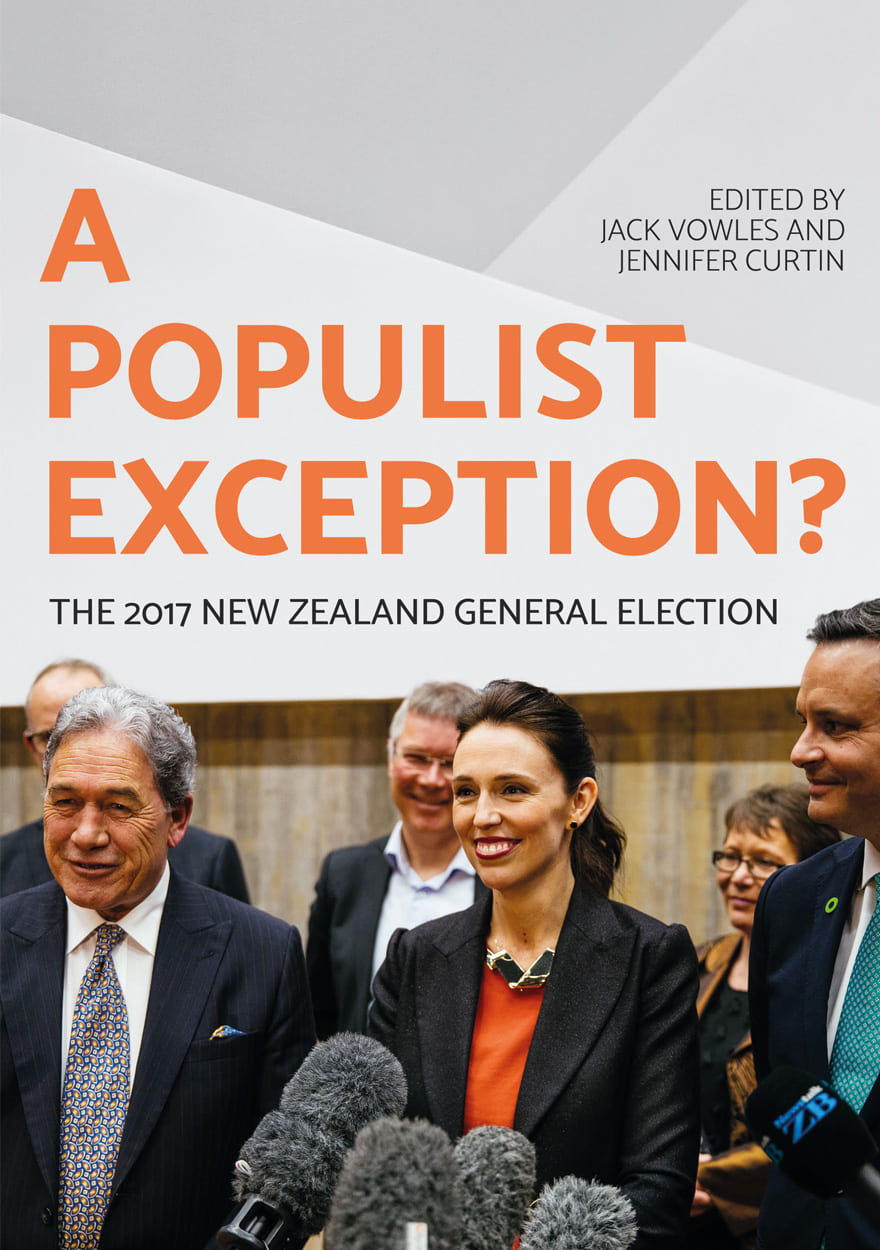
A Populist Exception? The 2017 New Zealand General Election
Edited by Jack Vowles and Jennifer Curtin
Publisher: ANU Press, Canberra
The ‘spectre of populism’ might be an apt description for what is happening in different parts of the world, but does it apply to New Zealand? Immediately after New Zealand’s 2017 general election, populist party New Zealand First gained a pivotal role in a coalition with the Labour Party, leading some international observers to suggest it represented a populist capture of the government. The leader of New Zealand First, Winston Peters, justified his support for Labour as necessary to allow capitalism to ‘regain … its human face’. The new prime minister, Jacinda Ardern, spoke of a kinder, inclusive politics.
This book draws on the 2017 New Zealand Election Study to uncover New Zealanders’ political attitudes and preferences post-election. Its authors ask: is New Zealand now A Populist Exception? Through detailed empirical analyses of how populism and authoritarianism affected vote choice, opinions about immigration, satisfaction with democracy and the relevance of gender and indigeneity to these issues, this book finds that New Zealand politics today does not reflect the international trend toward ideological polarisation and electoral volatility. The authors argue that inclusive forms of populism can be pluralist if a leader’s rhetorical approach recognises ‘the people’ as diverse and encompassing. A Populist Exception? concludes that although populism has long been a strong current in New Zealand history, contemporary New Zealand exhibits a moderate form of populism, with liberal and pluralist values in balance with a strong commitment to majoritarian democracy.

A Bark But No Bite: Inequality and the 2014 New Zealand General Election
Jack Vowles, Hilde Coffe, and Jennifer Curtin
Publisher: ANU Press, Canberra
A Bark But No Bite provides an account of the 2014 general election in New Zealand, and inquires into the implications of social and economic inequality as a matter of political party contest in the election. The authors chose the latter as a theme both because of its importance both nationally and internationally, and because it posed a puzzle. Adapting a metaphor from a famous Sherlock Holmes story, during the 2014 election campaign inequality was a dog that barked, but did not bite. On the basis of well-known assumptions, its salience in the campaign should have benefitted the centre-left, but did not. In a nutshell, this was its starting point.
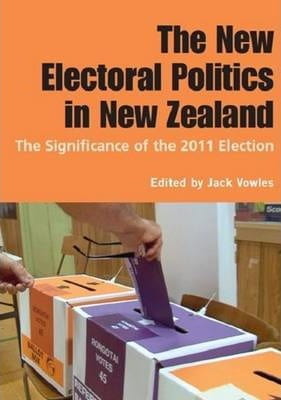
The New Electoral Politics in New Zealand: the Significance of the 2011 Election
Edited by Jack Vowles
Contributors: Jack Vowles (Victoria University of Wellington), Peter Aimer (formerly at the University of Auckland), Gerald Cotterell, Jennifer Curtin, Louise Humpage, Aimee Matiu, Raymond Miller, Ann Sullivan and Martin Von Randow (all currently at the University of Auckland), Charles Crothers (AUT University), Jeffrey A. Karp (Australian National University), and Thomas Lundberg (University of Glasgow).
Publisher: Institute for Governance and Policy Studies, School of Government, Victoria University of Wellington.
Around the world there was unusual interest in New Zealand’s electoral politics during the 1990’s, because of the country’s adoption of the Mixed Member Proportional (MMP) electoral system. Since then international interest has lapsed. Yet at the 2011 election and concurrent referendum, New Zealanders voted to retain the MMP system. Among other inquiries, this book asks the question: why?
Looking back to the 2011 election and before, this book lays out the current state of the play in New Zealand electoral politics. Despite its reservations about MMP, the National Party has done very well under that system, particularly since 2005, with a vote share and polling that brought it well within reach of a single party majority in 2014. For these reasons National appears unwilling to change the MMP system in ways recommended by an independent review conducted by the Electoral Commission. This book explores these questions, as well as others, including voter turnout decline, attitudes to welfare reform, women’s representation, changes in MÄori politics, and the growing importance of immigration on New Zealand politics and society.
Please contact the publisher for further information about ordering: igps@vuw.ac.nz.
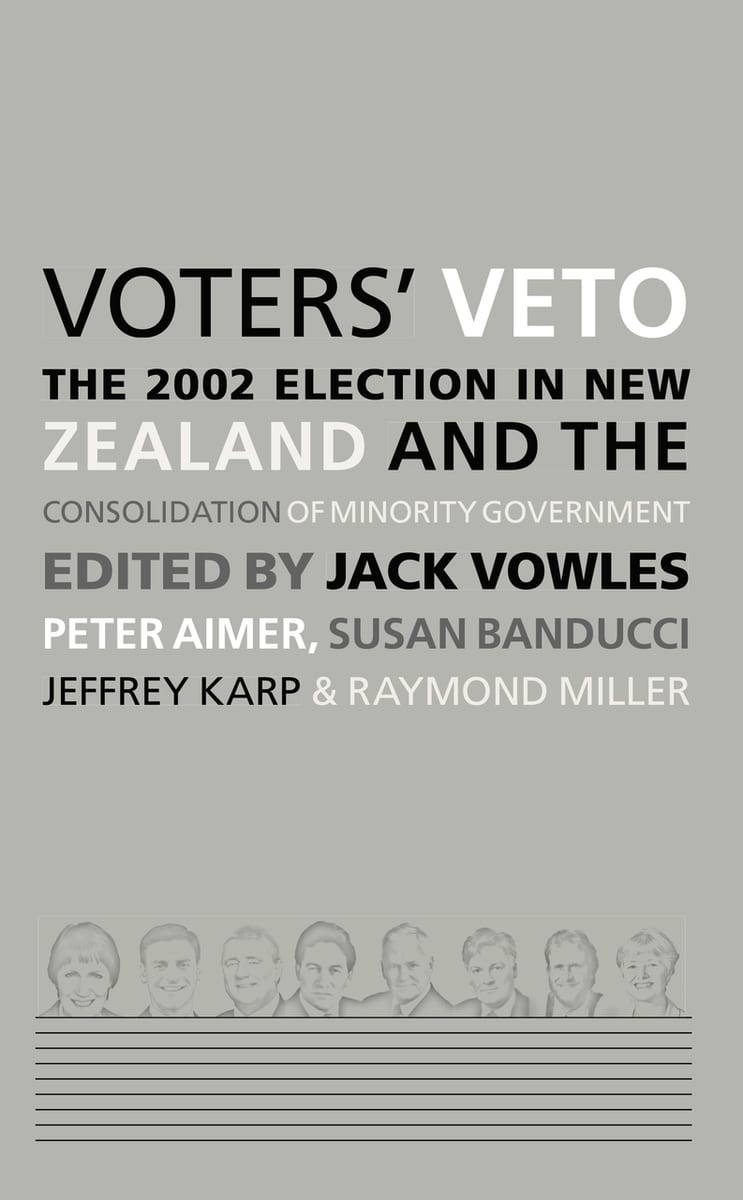
Voter’s Veto: The 2002 Election in New Zealand and the Consolidation of Minority Government
Edited by Jack Vowles, Peter Aimer, Jeffrey Karp, Susan Banducci, and Raymond Miller
Publisher: Auckland University Press
The title of this book sums up one of the main features of the 2002 Election in New Zealand. Before Labour Prime Minister Helen Clark called the election, opinion polls had foreshadowed a possible outright win for her party. Presented with the prospect of a majority government, a significant number of voters decided to withdraw their support from Labour, and therefore vetoed that option, robbing Labour of the chance to practise ‘unbridled power’, but making it possible for Labour to form another minority government.
A Scandinavian-style party system appeared to have emerged, with Labour in a strategically dominant position, at least for the time being, its electoral support exceeding that of the next largest party, National, by more than 20 per cent. Yet despite significant changes in the fortunes of the parties, the turnout of voters on the day declined to a New Zealand low.
All this makes the 2002 election both a landmark and a puzzle. The 2002 election campaign appeared even more volatile than 1996, the first New Zealand election under proportional representation. What led to this volatility, and to these outcomes? What are the consequences of the election for the political process and for New Zealanders’ trust and confidence in it? Is minority government within a moderately fragmented party system the most likely pattern for the immediate future of New Zealand politics? Will voters continue to veto the prospect of one party claiming power for itself alone? This book seeks to answer these and many other questions.
Please contact the publisher for further information about ordering: aup@auckland.ac.nz
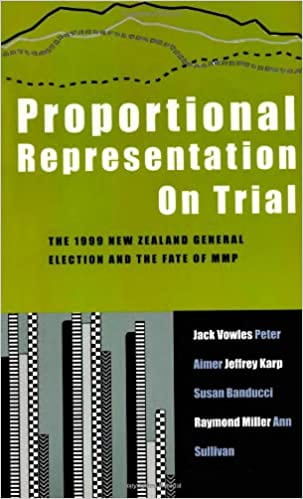
Winner of the Electoral Commission’s 2002 Wallace Award
Proportional Representation on Trial: The 1999 New Zealand General Election and the Fate of MMP
Edited by Jack Vowles, Peter Aimer, Jeffrey Karp, Susan Banducci, Raymond Miller, and Ann Sullivan
Publisher: Auckland University Press
The 1999 general election was a memorable one. The last electoral contest of the 20th century, it brought down the political curtain on a dramatic decade, which ended as it began with a complete change of government. At the beginning of the decade, the Fourth Labour government had been swept away by National in a classic landslide election. In 1999, Labour returned to power as the main party in a coalition minority government. Proportional representation in the form of MMP made the difference. In 1993, the deeply disillusioned electorate had voted for a new electoral system. The transition to proportional representation added to the political turmoil of the decade. MMP ushered in a larger parliament, a new balance of parties, and ended the era of one-party majority governments. After the first MMP election in 1996, the unexpected formation of the National-New Zealand First coalition bewildered and outraged many people. Within National, Jenny Shipley toppled Jim Bolger from leadership to become the country’s first woman Prime Minister. New Zealand First splintered, and the coalition collapsed. In the eyes of most electors by 1999, proportional representation was on trial, along with the political parties.
Proportional Representation on Trial is the fourth in a series of election studies funded by the Foundation for Research, Science and Technology, that documents the electoral politics of a remarkable decade. Based on the most extensive surveys of public opinion undertaken in New Zealand, it delves into the dynamics of an election campaign dominated by two closely-matched women leaders; the return of Maori voters to their historic Labour preference; the emergence of the Greens; and the developing foundations of the Labour-Alliance coalition. It traces the evolution of public attitudes to MMP, presents a comprehensive assessment of the effects of proportional representation, and discusses the experiment of the two citizens initiated referendums.
Please contact the publisher for further information about ordering: aup@auckland.ac.nz.
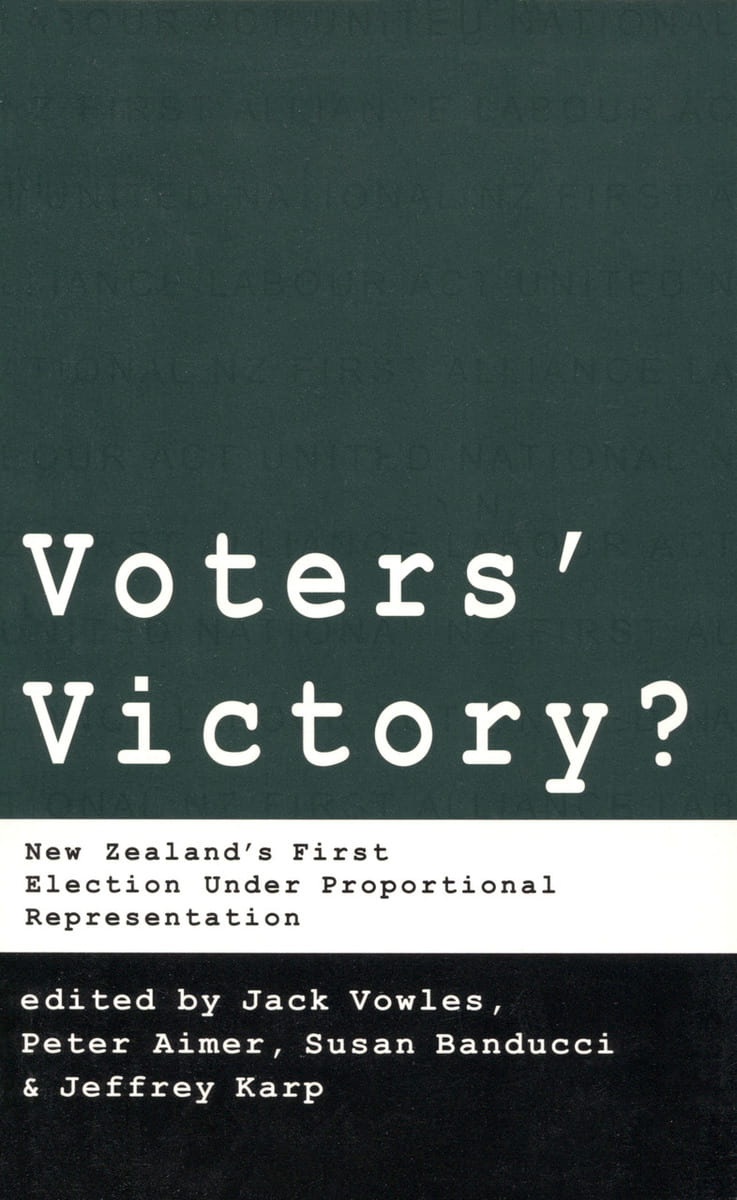
Winner of the Electoral Commission’s 1998 Wallace Award
Voters’ Victory? New Zealand’s First Election Under Proportional Representation
Edited by Jack Vowles, Peter Aimer, Susan Banducci, and Jeffrey Karp
Publisher: Auckland University Press
What happens when a country moves away from British-style, two-party politics and towards multiparty politics, adopting a European system of Mixed-Member proportional representation (MMP)? Voters’ Victory? explores this question comprehensively and in depth. New Zealand’s historic first MMP election was held on 12 October 1996 . This book examines what New Zealanders could expect from MMP on the basis of international experience and theory, then focuses on the distinctive features of the election and its outcome: the party changes; the patterns of voting; how people used their votes; shifts in support for parties and leaders in the campaign; the composition of the new Parliament; the capture of the Maori seats by New Zealand First; and the fateful National-New Zealand First Coalition outcome.
New Zealand’s switch to proportional representation, like its economic reforms of the last decade, has attracted international interest. Scholars from Australia , the United States and Canada, as well as New Zealand, are among the contributing authors to this first authoritative analysis of a landmark election.
Voters’ Victory? is the third major study of voters and electoral choice in New Zealand since 1990, based on the nationwide, post-election surveys of electors and candidates, conducted by the New Zealand Election Study programme and funded by the Foundation for Research, Science, and Technology (FRST).
Voters’ Victory? is available now for a cost of $NZ 39.95 ($US 23.50) and can be ordered directly from the publisher at: aup@auckland.ac.nz.
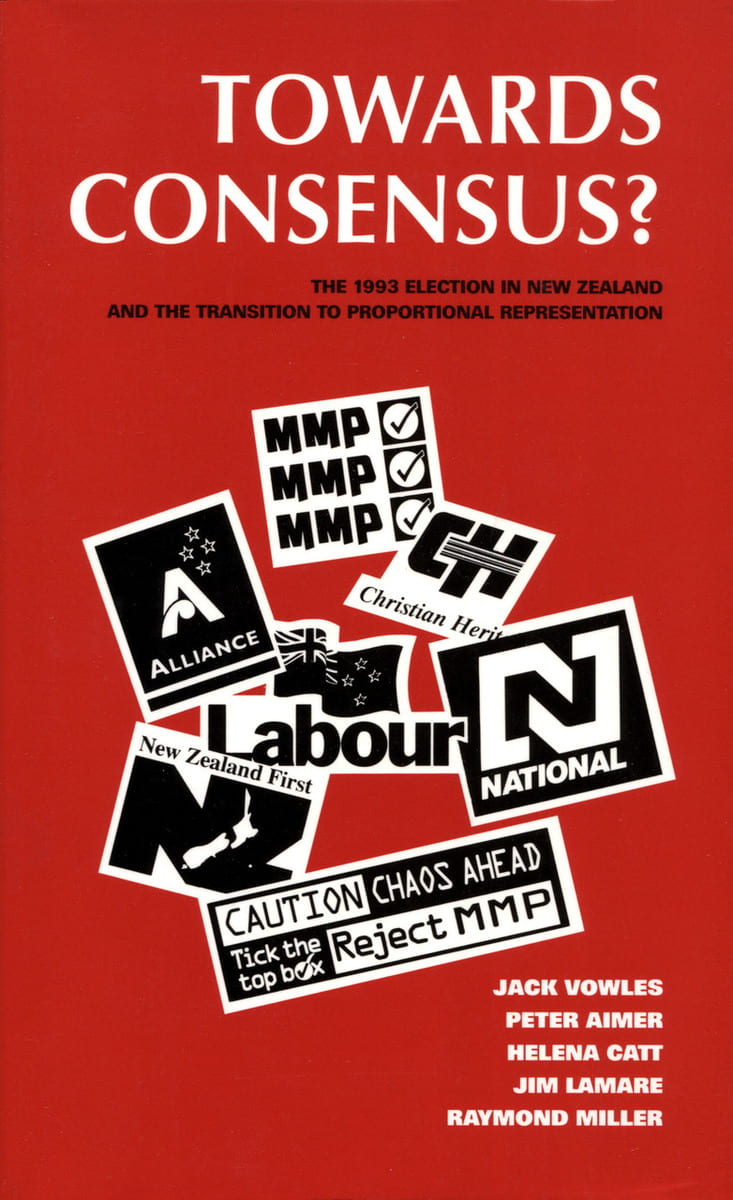
Towards Consensus? The 1993 Election in New Zealand and the Transition to Proportional Representation
Jack Vowles, Peter Aimer, Helena Catt, Jim Lamare, and Raymond Miller
Publisher: Auckland University Press
The election of 6 November 1993 was one of the most tense and significant in New Zealandís history. When the votes were counted Nationalís large majority had vanished and Labour had almost as many seats in the House. The date was also a political and constitutional turning point; for at the same time voters had rejected the first-past-the-post electoral system in favour of MMP, a form of proportional representation that would re-shape the structure of future party competition.
Towards Consensus? Seeks to explain the results of the election and referendum and examines their implications for the future of New Zealand politics under the new electoral system. The authors build their analysis on the rich data provided by replies of over 2000 voters and more than 1000 political party activists and parliamentary candidates surveyed immediately after the election.
Using this information they are able to follow the changes to peopleís party choices from 1990 to 1993. They trace the sources of support for the new multi-party Alliance and New Zealand First, and shed light on Nationalís spectacular electoral losses and Labourís disappointments in 1993. The analysis takes account of the wide range of values, personal attitudes, and judgements of policies and politicians that people bring to the ballot box. It explores the similarities and differences in outlook among voters and those who seek to represent them. It also discusses the electoral background to MMP and looks ahead to the emergence of multi-party politics under the new system.
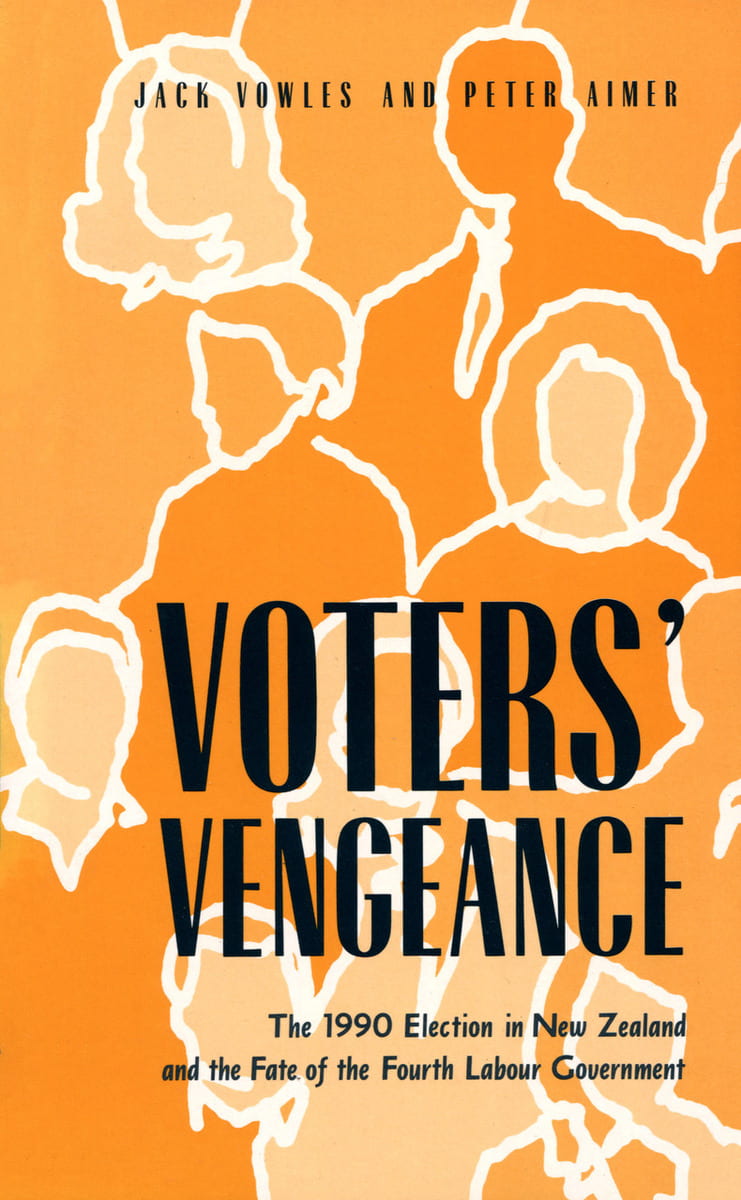
Voters’ Vengeance: The 1990 Election in New Zealand and the Fate of the Fourth Labour Government
Jack Vowles and Peter Aimer
Publisher: Auckland University Press
The 1990 election produced New Zealand ‘s most dramatic parliamentary transformation in over fifty years. Labour plunged from 56 seats to 29, while National rose from 41 to 67. Rubbing salt into Labour’s deep electoral wounds, Jim Anderton, who had left Labour to establish and lead the NewLabour Party, retained the ninety-seventh seat. It was Labour’s worst result by far since 1931. Meanwhile a new party, the Greens, emerged as New Zealand ‘s largest and most popular ‘third’ party.
Many people, disappointed and disillusioned with the Labour Government, justified their participation in its defeat as an act of revenge. Yet if Labour lost because voters abandoned it in large numbers, National did not win because it received massive support and its huge parliamentary majority was partly a quirk of New Zealandís first-past-the-post electoral system.
This book documents the election in a way that has never been done before in New Zealand . It recalls the major landmarks of the Fourth Labour Governmentís eventful term, but does so largely from the perspective of the voters themselves. It draws on information contained in over 2000 replies to a national random survey of New Zealanders just after the election. It maps the movement of voters since 1984 and it shows how different groups of people responded to the wide range of economic, social, environmental and gender issues that emerged during the often stormy years of the Lange-Palmer-Moore period. Many of the changes of this time were not unique, however, but were part of an international process: the authors have also linked the political responses of New Zealanders to international patterns and trends in voting behaviour. An important and illuminating study.